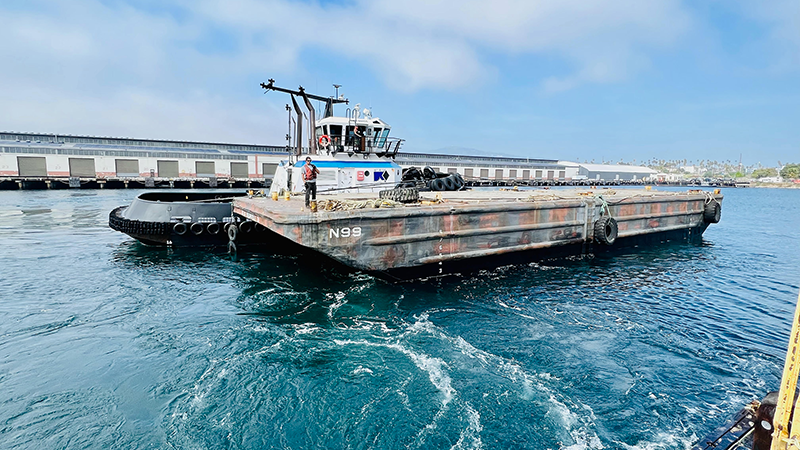UCLA Institute for Carbon Management to Unveil Seawater-based Carbon Removal Pilot Systems in Los Angeles and Singapore
SeaChange technology will utilize oceans to remove billions of metric tons of carbon dioxide from the atmosphere

Nick Hajek/AltaSea
Seawater intake-support equipment being put into place to facilitate UCLA’s SeaChange Demonstration Plant at AltaSea at the Port of Los Angeles
UCLA Samueli Newsroom
A research team led by faculty from the UCLA Samueli School of Engineering is working to prime the oceans to trap atmospheric carbon dioxide (CO2), the man-made increase of which is the underlying cause of climate change.
SeaChange, a startup born out of the technology developed at UCLA, announced this week that two pilot systems — one in LA and another in Singapore — will soon be operational to help mitigate the atmospheric accumulation of carbon dioxide.
UCLA’s Institute for Carbon Management (ICM), which spearheads SeaChange and other innovative carbon removal, mitigation and utilization programs, has recently received additional funding for the development of the SeaChange technology, including $1 million from the U.S. Department of Energy’s Advanced Research Projects Agency-Energy Program and $1.5 million through the 2019 Volkswagen Fuel Economy Settlement. The latest funding came on the heels of a $21 million pledge to ICM from the Chan Zuckerberg Initiative and other previously announced support.
“The oceans are the world’s largest sink of carbon dioxide emissions,” said Gaurav Sant, the director of ICM and a professor of civil and environmental engineering and materials science and engineering who holds UCLA’s Pritzker Chair in Sustainability. “This technology can electrochemically enhance and restore the oceans’ capacity for carbon dioxide removal from the atmosphere at a globally relevant scale, thereby mitigating ongoing and accelerating climate change.”
“This technology can electrochemically enhance and restore the oceans’ capacity for carbon dioxide removal from the atmosphere at a globally relevant scale, thereby mitigating ongoing and accelerating climate change,” said Gaurav Sant, director of UCLA’s Institute for Carbon Management.
Working with industry leaders, national agencies and government leadership, the two pilot plants will intake seawater, which holds nearly 150 times more carbon dioxide than air, and leverage the SeaChange technology to convert dissolved carbon dioxide, calcium and magnesium into solid limestone and brucite (the mineral form of magnesium hydroxide) — in a manner similar to how some marine organisms form seashells. The alkalinized outgoing seawater, depleted of CO2, is then able to absorb more of the greenhouse gas just like a sponge, rinsing and repeating the same process. The ready-to-scale method also yields hydrogen gas as a co-product, which can be used as a clean fuel.
“These projects will define protocols and strategies for measurement, verification and optimal project siting. They will also help us develop operational best practices to ensure scalable, cost-effective and durable carbon dioxide removal,” said Dante Simonetti, an associate professor of chemical and biomolecular engineering at UCLA Samueli and the institute’s associate director for technology translation. “The successful operation of these plants will lead to the rapid adoption of this technology at much larger scales.”
The team has partnered with AltaSea at the Port of Los Angeles and the Public Utilities Board — Singapore’s National Water Agency — to demonstrate the technology early next year.
“Site preparation at both locations is underway for SeaChange’s pilot systems,” said Thomas Traynor, who is the technical leader of ICM’s technology translation efforts. “These first-of-a-kind systems will reveal the precise scaling relationships needed to build larger plants and help quantify the cost of plants and equipment, as well as the amount of energy needed to remove CO2 from the atmosphere. And we expect ongoing development of the technology will reduce the cost and energy demands of the process.”
According to the researchers, roughly 1,800 industrial-scale plants would sequester about 10 billion tons of atmospheric carbon dioxide per year, making a major dent in the 37 billion tons of the gas emitted each year. Even at smaller scales and numbers, the team said the technology could play a critical role in carbon mitigation.
In addition to launching the two pilot systems, the Institute of Carbon Management also announced the appointment of entrepreneur and scientist Lorenzo Corsini as the principal advisor to the SeaChange effort.
